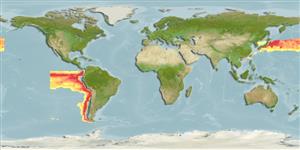Actinopterygii (ray-finned fishes) >
Lophiiformes (Anglerfishes) >
Oneirodidae (Dreamers)
Etymology: Puck: From the Germanic folklore, a minor order of mischievous devils, sprites, goblins, and demons; a devilish trickster (Ref. 86949).
Environment / Climate / Range
Ecology
Marine; bathypelagic; depth range 1464 - 4073 m (Ref. 86949). Deep-water, preferred ?
Northwest Pacific: known from the type locality, 38°16'N, 152°34'E and Galapagos Islands (Ref. 86949).
Size / Weight / Age
Maturity: Lm ? range ? - ? cm
Short description
Morphology | Morphometrics
Dorsal
soft rays
(total): 5;
Anal
soft rays: 4. Metamorphosed females distinguished by the following characteristics: wide ethmoid cartilage and vomer, wider than distance between anterolateral tips of lateral ethmoids and frontals; presence of vomerine teeth; nasal foramina large and oval in shape; short frontals, lying posterior to the ethmoid region, strongly convex dorsal margin; ventromedial extensions of frontals approach each other on midline, making contact with parasphenoid; frontals separated from prootics; presence of pterosphenoid; anterior end of illicial trough wider and shallower than posterior end; extremely well developed sphenotic spines; symphysial cartilage of upper jaw longer than wide; lower jaw with well developed symphysial spine; hyomandibula with double head; extremely well developed quadrate spine, nearly six times the length of articular spine; deeply notched posterior margin of opercle; subopercle small, elongate and narrow throughout its length, dorsal end tapering to a point, rounded ventral end; absence of first pharyngobranchial; well developed second pharyngobranchial; second hypobranchial directly articulates with second basibranchial; caudal fin rays without internal pigmentation; illicium longer than length of esca bulb; pterygoiphore of illicium cylindrical throughout its length, emerging on snout from between frontal bones, anterior end slightly exposed, posterior end concealed beneath skin; well developed first ray of dorsal fin; dorsal fin rays 5; anal fin rays 4; long and narrow pectoral fin lobe, longer than longest rays of pectoral fin; pectoral fin rays 19-20; coracoid lacking posteroventral process; simple pelvic bones, slightly expanded distally; skin is naked, without dermal spinules; darkly pigmented skin of caudal peduncle extends well past base of caudal fin (Ref. 86949).
Presumably bathypelagic.
Life cycle and mating behavior
Maturity | Reproduction | Spawning | Eggs | Fecundity | Larvae
Eschmeyer, W.N. (ed.), 2003. Catalog of fishes. Updated database version of March 2003. Catalog databases as made available to FishBase in March 2003. (Ref. 46206)
IUCN Red List Status (Ref. 115185)
CITES (Ref. 94142)
Not Evaluated
Threat to humans
Harmless
Human uses
More information
Common namesSynonymsMetabolismPredatorsEcotoxicologyReproductionMaturitySpawningFecundityEggsEgg development
Age/SizeGrowthLength-weightLength-lengthLength-frequenciesMorphometricsMorphologyLarvaeLarval dynamicsRecruitmentAbundance
ReferencesAquacultureAquaculture profileStrainsGeneticsAllele frequenciesHeritabilityDiseasesProcessingMass conversion
Tools
Special reports
Download XML
Internet sources
